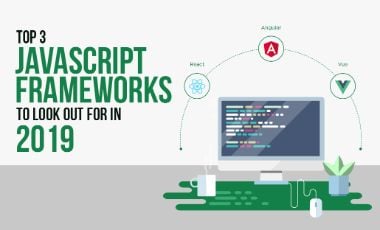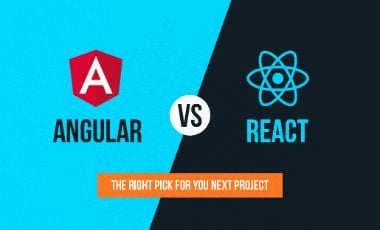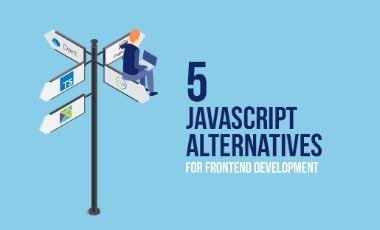Navigating the process of selecting the ideal framework can be perplexing. To make an informed decision, it's essential to delve into JavaScript frameworks, grasp crucial concepts, and gain the insights necessary for effectively incorporating the top frameworks into your software development endeavors.
A recent Stack Overflow Survey 2023 shows the JavaScript framework maintaining its position as the most widely utilized programming language for the 11th consecutive year.
Despite its consistency, the realm of web development is abundant with emerging frameworks, libraries, and programming languages. Notably, JavaScript itself boasts a repertoire of over 24 frameworks and an extensive array of libraries.
Let’s know which JavaScript frameworks work better. We'll show you how to use the best frameworks in your work.
Exploring JavaScript Frameworks: Are They the Same as JavaScript Libraries?
Frameworks are like building blocks for web apps – they save time by providing a ready-made structure. Libraries are toolkits for specific tasks. Think of frameworks as app blueprints and libraries as handy tools.
Simply put, it’s a framework that gives you an overall plan for your app, while a library gives you tools to do specific jobs within your app.
JavaScript vs. Other Web Development Frameworks
JavaScript is often compared to other popular frameworks like PHP and TypeScript. Although all of them are used for web development, they function very differently. Here's a quick comparison of JavaScript vs. TypeScript and PHP vs. JavaScript.
|
Aspect |
JavaScript |
TypeScript |
PHP |
|
Role |
Client-side scripting (APIs, mobile apps, real-time apps) |
An enhanced version of JavaScript with strict rules and type declarations |
Server-side scripting (Dynamic web page creation) |
|
Error Handling |
Errors may appear during program execution |
Catches errors during compilation |
N/A (interpreted at runtime) |
|
Flexibility |
Flexible, loosely defined for quick idea testing |
Enhanced code quality through type specifications and rules |
N/A |
|
Notable Advantage |
N/A |
Early error detection for better code quality |
N/A |
|
Use Cases |
Client-side web development, APIs, mobile apps, real-time applications |
Enhanced code maintainability and scalability, suitable for larger projects |
Server-side web development, dynamic web page creation |
Now that we've covered this groundwork let's delve into the world of top JavaScript frameworks for web development.
Best JavaScript Frameworks in 2023: That Are a Must-Have in Your Tech Stack
JavaScript frameworks are divided into three types. Each type serves a different purpose.
1. Frontend JavaScript frameworks
2. Backend JavaScript frameworks
3. Testing JavaScript Framework
Frontend JavaScript Frameworks
Frontend JavaScript frameworks help developers build user interfaces. Let's see how these can help and which ones are the most popular frameworks:
1. ReactJS
In 2016, Facebook (now Meta) launched ReactJS, an early cross-platform framework. It gained popularity due to support from Facebook engineers and a growing community.
Features and Advantages:
- ReactJS powers Facebook, making it suitable for high-usage applications.
- It employs a one-way data flow for app stability.
- Reusable components reduce web app development costs.
Practical Applications:
Netflix, Dropbox, and Facebook use ReactJS for web apps, supported by Facebook's engineering. ReactJS is now a top global JavaScript framework.
2. Vue.JS
VueJS, created by Evan You at Google in 2013, combines AngularJS's strengths in a lighter framework. While praised for speed and concise documentation, VueJS's flexibility has led to concerns about inconsistent code.
Features:
- Virtual DOM boosts loading speed.
- Two-way data binding minimizes code.
- Concise documentation aids learning.
Practical Applications:
VueJS suits single-page apps and prototypes. Netflix, Nintendo, and Wizz Air use VueJS.
3. AngularJS
AngularJS, developed by Google in 2010, is renowned for dynamic web apps. Its strong foundation in JavaScript and HTML enables swift app creation for those familiar with these languages. Yet, AngularJS's development has ceased, with Google no longer contributing.
Features:
- Real-time testing aids maintenance.
- Reusable code accelerates development.
- Ideal for initial app prototypes with minimal code.
Practical Applications:
AngularJS suits real-time apps, e-commerce, video streaming, content management, and more.
Backend JavaScript Frameworks
1. Node.JS
NodeJS, pivotal since 2009, excels as a runtime environment for scalable applications, not just a framework. It's downloaded over 1 billion times.
Features:
- Handles multiple tasks for scalability.
- Bundles Node package manager with a million libraries.
- Lightweight for swift development.
Applications:
NodeJS is versatile, serving both the backend and frontend. Big names like Netflix, NASA, PayPal, and more use it.
2. Next.JS
NextJS, introduced by Guillermo Rauch in 2016, stands out with two-way rendering: server-side and client-side code. This boosts site SEO and accessibility, earning it 91,700 stars, surpassing Kubernetes.
Features:
- Independent from NodeJS.
- Server-side rendering and auto code splitting for speed.
Applications:
NextJS enhances React with server-side rendering. Used by Hulu, Netflix, Uber, Twitch, and more, it's ideal for e-commerce and corporate sites.
Testing JavaScript Framework
1. MochaJS
MochaJS is a popular testing framework for JavaScript apps on NodeJS. Its flexibility allows seamless integration with different libraries. It's browser-compatible, identifies slow tests, and supports test retries. MochaJS customizes test reports but has a complex setup.
Usage:
Over 654 companies use MochaJS, including Accenture, Intuit, Coursera, and Asana.
2. Jest
Jest, from Facebook, is a popular, fast JavaScript testing framework. Airbnb reduced testing time from 12 to 4.5 mins using Jest. Detailed failure context aids understanding.
Features:
- Speed due to parallel testing and slow test prioritization.
- TypeScript support suits TypeScript apps.
- Built-in coverage reports for tested code insight.
Usage:
Pinterest, Instagram, and Twitter use Jest. Its appeal lies in speed, clarity, and modern practices compatibility.
Need to Hire JavaScript Developers?
JavaScript frameworks make web development smoother, letting you build solid and flexible apps quickly. They work for any tech, business, or size. But here's the thing: talented developers are the secret sauce.
That's where Clarion Technologies steps in – we've got top-notch JavaScript pros ready to make your dream website a reality. Reach out to us; your dreams know no bounds when you've got the right team!









